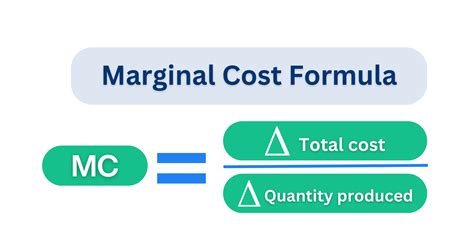How to Calculate Marginal Cost: A Simple Guide for Businesses
Understanding marginal cost is crucial for businesses of all sizes. It's a key concept in microeconomics that helps businesses make informed decisions about production, pricing, and profitability. This guide will break down how to calculate marginal cost, offering practical examples and tips to make it easy to understand.
What is Marginal Cost?
Marginal cost represents the increase in total production cost that comes from producing one additional unit of output. It's not about the average cost of all units produced, but the cost specifically associated with that one extra unit. Think of it as the cost of producing one more.
In simple terms: Marginal cost = (Change in Total Cost) / (Change in Quantity)
How to Calculate Marginal Cost: A Step-by-Step Guide
Let's illustrate with an example. Imagine a bakery producing cakes.
Step 1: Determine Total Costs
First, you need to identify your total production costs at different output levels. This includes all costs associated with production, such as:
- Direct Costs: These are directly tied to production (e.g., flour, sugar, eggs, labor directly involved in cake making).
- Indirect Costs (Overhead): These are not directly tied to production but are necessary for operation (e.g., rent, utilities, insurance).
Let's assume the following data for our bakery:
| Quantity of Cakes | Total Cost ($) |
|---|---|
| 0 | 100 |
| 10 | 200 |
| 20 | 280 |
| 30 | 340 |
| 40 | 400 |
Note: The initial cost of $100 represents fixed overhead costs (rent, utilities, etc.), which are incurred even with zero production.
Step 2: Calculate the Change in Total Cost
For each increase in cake production, calculate the difference in total cost.
- From 0 to 10 cakes: Change in Total Cost = $200 - $100 = $100
- From 10 to 20 cakes: Change in Total Cost = $280 - $200 = $80
- From 20 to 30 cakes: Change in Total Cost = $340 - $280 = $60
- From 30 to 40 cakes: Change in Total Cost = $400 - $340 = $60
Step 3: Calculate the Change in Quantity
This is the difference in the number of cakes produced. In our example, the change in quantity is consistently 10 cakes.
Step 4: Calculate Marginal Cost for Each Increment
Now, divide the change in total cost by the change in quantity for each increment:
- Marginal Cost (0-10 cakes): $100 / 10 = $10 per cake
- Marginal Cost (10-20 cakes): $80 / 10 = $8 per cake
- Marginal Cost (20-30 cakes): $60 / 10 = $6 per cake
- Marginal Cost (30-40 cakes): $60 / 10 = $6 per cake
Interpreting Marginal Cost
Notice that the marginal cost decreases initially and then stabilizes. This is a common pattern. It reflects economies of scale – as production increases, the cost per unit often decreases (until a certain point). However, at some point, marginal cost may start to rise again due to factors like resource constraints or diminishing returns.
Why is Marginal Cost Important?
Understanding marginal cost is vital for:
- Pricing Decisions: Setting prices that cover marginal cost is crucial for profitability.
- Production Planning: Identifying the optimal production level where marginal cost is minimized or balanced against marginal revenue.
- Cost Control: Identifying areas where production costs can be reduced.
By understanding and applying these calculations, businesses can make better decisions, improve efficiency, and boost profitability. Remember to always consider both fixed and variable costs when calculating marginal cost for a complete picture of your business expenses.
